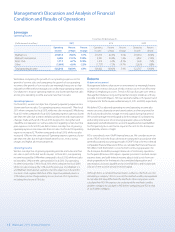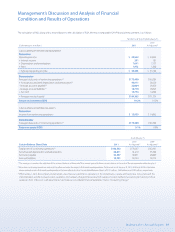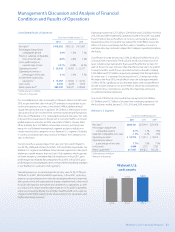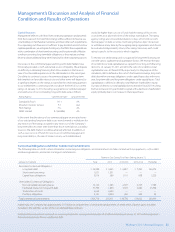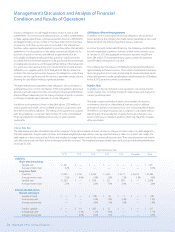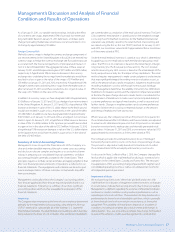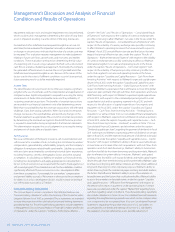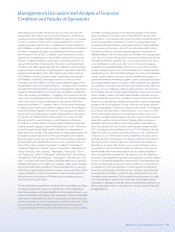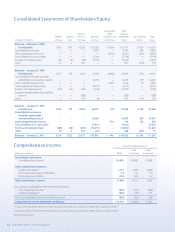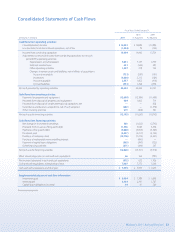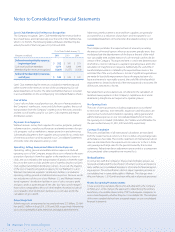Walmart 2011 Annual Report Download - page 30
Download and view the complete annual report
Please find page 30 of the 2011 Walmart annual report below. You can navigate through the pages in the report by either clicking on the pages listed below, or by using the keyword search tool below to find specific information within the annual report.
Management’s Discussion and Analysis of Financial
Condition and Results of Operations
28 Walmart 2011 Annual Report
impairment indicators exist and require impairment tests be performed,
which could result in management determining the value of long-lived
assets is impaired, resulting in a write-down of the long-lived assets.
Goodwill and other indenite-lived acquired intangible assets are not
amortized, but are evaluated for impairment annually or whenever events
or changes in circumstances indicate that the value of a certain asset may
be impaired. This evaluation requires management to make judgments
relating to future cash ows, growth rates, and economic and market
conditions. These evaluations are based on determining the fair value
of a reporting unit or asset using a valuation method such as discounted
cash ow or a relative, market-based approach. Historically, the Company
has generated sucient returns to recover the cost of goodwill and other
indenite-lived acquired intangible assets. Because of the nature of the
factors used in these tests, if dierent conditions occur in future periods,
future operating results could be materially impacted.
Income Taxes
The determination of our provision for income taxes requires signicant
judgment, the use of estimates, and the interpretation and application of
complex tax laws. Signicant judgment is required in assessing the timing
and amounts of deductible and taxable items and the probability of
sustaining uncertain tax positions. The benets of uncertain tax positions
are recorded in our nancial statements only after determining a more-
likely-than-not probability that the uncertain tax positions will withstand
challenge, if any, from taxing authorities. When facts and circumstances
change, we reassess these probabilities and record any changes in the
nancial statements as appropriate. We account for uncertain tax positions
by determining the minimum recognition threshold that a tax position
is required to meet before being recognized in the nancial statements.
This determination requires the use of judgment in assessing the timing
and amounts of deductible and taxable items.
Self-Insurance
We use a combination of third-party insurance, self-insured retention and
self-insurance for a number of risks, including, but not limited to, workers’
compensation, general liability, vehicle liability, property and the Company’s
obligation for employee-related health care benets. Liabilities associated
with any claims are estimated by considering historical claims experience,
including frequency, severity, demographic factors and other actuarial
assumptions. In calculating our liability, we analyze our historical trends,
including loss development, and apply appropriate loss development
factors to the incurred costs associated with the claims made against our
self-insured program. The estimated accruals for these liabilities could be
signicantly aected if future occurrences or loss development dier
from these assumptions. For example, for our workers’ compensation
and general liability accrual, a 1% increase or decrease to the assumptions
for claims costs or loss development factors would increase or decrease
our self-insurance accrual by $27 million.
Forward-Looking Statements
This Annual Report contains statements that Walmart believes are
“forward-looking statements” within the meaning of the Private Securities
Litigation Reform Act of 1995, as amended. Those statements are intended
to enjoy the protection of the safe harbor for forward-looking statements
provided by that Act. Those forward-looking statements include statements
in Management’s Discussion and Analysis of Financial Condition and Results
of Operations: under the captions “Company Performance Metrics –
Growth – Net Sales” and “Results of Operations – Consolidated Results
of Operations” with respect to the volatility of currency exchange rates
possibly continuing to aect Walmart’s net sales in the future; under the
caption “Results of Operations – Consolidated Results of Operations” with
respect to the volatility of currency exchange rates possibly continuing
to aect Walmart’s operating income in the future and with respect to
Walmart’s scal 2012 annual eective tax rate and the factors that may
impact that annual eective tax rate; under the caption “Results of
Operations – Walmart International Segment” with respect to the volatility
of currency exchange rates possibly continuing to aect our Walmart
International segment’s net sales and operating results in the future;
under the caption “Results of Operations – Sam’s Club Segment” with
respect to the volatility of fuel prices possibly continuing to aect our
Sam’s Club segment’s net sales and operating income in the future;
under the caption “Liquidity and Capital Resources – Cash Flows from
Investing Activities” with respect to Walmart’s expected capital expen-
ditures in scal 2012; under the caption “Liquidity and Capital Resources –
Cash Flows from Investing Activities – Global Expansion Activities” with
respect to Walmart’s expectation that it will nance its scal 2012 global
expansion plans primarily through cash ows from operations and future
debt nancings, with respect to Walmart’s expected capital expenditures
in scal 2012, with respect to the estimated/projected growth in retail
square feet in total and by operating segment in scal 2012 and with
respect to the allocation of capital expenditures for property and
equipment in scal 2012; under the caption “Liquidity and Capital
Resources – Cash Flows from Investing Activities – Pending Business
Acquisitions”, as well as in Note 15 to our Consolidated Financial Statements,
with respect to Walmart’s expected consummation of certain acquisitions
in scal 2012; under the caption “Liquidity and Capital Resources – Cash
Flows from Financing Activities – Dividends”, as well as in Note 17 to our
Consolidated Financial Statements and elsewhere under the caption
“Dividends payable per share”, regarding the payment of dividends in scal
2011 with respect to Walmart’s expected payment of dividends on certain
dates in scal 2012 and the expected total amount of dividends to be paid
in scal 2012; under the caption “Liquidity and Capital Resources – Capital
Resources” with respect to Walmart’s ability to nance seasonal build-ups
in inventories and to meet other cash requirements with cash ows from
operations and short-term borrowings, Walmart’s ability to fund certain
cash ow shortfalls by short-term borrowings and long-term debt, Walmart’s
plan to renance long-term debt as it matures, Walmart’s anticipated
funding of any shortfall in cash to pay dividends and make capital expen-
ditures through short-term borrowings and long-term debt, Walmart’s plan
to renance existing long-term debt as it matures and may obtain additional
long-term nancing for other corporate purposes, Walmart’s ability to
obtain nancing from the commercial paper and long-term debt markets,
the factors that inuence Walmart’s ability to access those markets on
favorable terms and the factors that could adversely aect Walmart’s ability
to access those markets on favorable terms; under the caption “Liquidity
and Capital Resources – Off Balance Sheet Arrangements” with respect to
the amount of increases in payments under operating leases if certain
leases are executed; and under the caption “Market Risk” regarding future
cash ows regarding certain instruments. These forward-looking statements
also include statements in: Note 4 to our Consolidated Financial Statements
regarding the weighted-average periods over which certain compensation
cost is expected to be recognized; Note 10 to our Consolidated Financial
Statements regarding the possible reduction of U.S. tax liability on
accumulated but undistributed earnings of our non-U.S. subsidiaries,
the realization of certain deferred tax assets, possible reduction of


